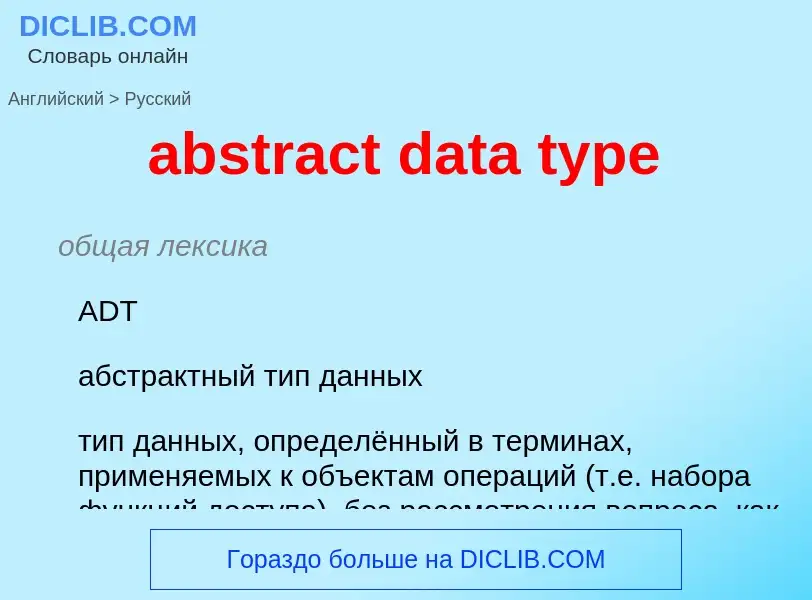Перевод и анализ слов искусственным интеллектом
На этой странице Вы можете получить подробный анализ слова или словосочетания, произведенный с помощью лучшей на сегодняшний день технологии искусственного интеллекта:
- как употребляется слово
- частота употребления
- используется оно чаще в устной или письменной речи
- варианты перевода слова
- примеры употребления (несколько фраз с переводом)
- этимология
abstract data type - перевод на русский
общая лексика
ADT
абстрактный тип данных
тип данных, определённый в терминах, применяемых к объектам операций (т.е. набора функций доступа), без рассмотрения вопроса, как эти объекты представлены в памяти. Такие типы данных поддерживаются, в частности, в языке Ada. В ООП каждый класс представляет собой ADT
общая лексика
тип данных
в программировании - характеристика, явно или неявно присваиваемая объекту (переменной, функции, полю записи, константе, массиву и т.п.). Тип данных определяет множество допустимых значений, формат хранения данных, размер выделяемой под них памяти и набор операций, которые над ними можно производить. Различают простые (базовые, стандартные) типы (integer, real, string) и сложные (произвольные) типы данных, такие как массивы и структуры
Определение
Википедия
In computer science, an abstract data type (ADT) is a mathematical model for data types. An abstract data type is defined by its behavior (semantics) from the point of view of a user, of the data, specifically in terms of possible values, possible operations on data of this type, and the behavior of these operations. This mathematical model contrasts with data structures, which are concrete representations of data, and are the point of view of an implementer, not a user.
Formally, an ADT may be defined as a "class of objects whose logical behavior is defined by a set of values and a set of operations"; this is analogous to an algebraic structure in mathematics. What is meant by "behaviour" varies by author, with the two main types of formal specifications for behavior being axiomatic (algebraic) specification and an abstract model; these correspond to axiomatic semantics and operational semantics of an abstract machine, respectively. Some authors also include the computational complexity ("cost"), both in terms of time (for computing operations) and space (for representing values). In practice, many common data types are not ADTs, as the abstraction is not perfect, and users must be aware of issues like arithmetic overflow that are due to the representation. For example, integers are often stored as fixed-width values (32-bit or 64-bit binary numbers), and thus experience integer overflow if the maximum value is exceeded.
ADTs are a theoretical concept, in computer science, used in the design and analysis of algorithms, data structures, and software systems, and do not correspond to specific features of computer languages—mainstream computer languages do not directly support formally specified ADTs. However, various language features correspond to certain aspects of ADTs, and are easily confused with ADTs proper; these include abstract types, opaque data types, protocols, and design by contract. ADTs were first proposed by Barbara Liskov and Stephen N. Zilles in 1974, as part of the development of the CLU language.


